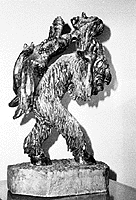
Home
Family
History
Coat of Arms
Military History
Lithuanian History
Shenandoah History
Image Galleries
Map Room
Scrapbook
Links
|
Popalis Family History

??/??/????
The St. Petersburg Times
http://www.sptimes.ru/
Devilish Fetish Celebrated At 'One Hell of a Museum'
By Katy Daigle
SPECIAL TO THE ST PETERSBURG TIMES

KATY DAIGLE/SPT
A devil carrying a weak priest on his back.
KAUNAS, Lithuania - The myth begins with a good Christian and patriot, Antanas Zmuidzinavicius, a folk artist, who saved many peoples' souls by going on a mission from house to house to rid his city of the fiendish devils wreaking havoc and unhappiness.
But the head devil himself - Satan, as some might call him - saw what Zmuidzinavicius was doing and called the lesser devils back to hell -all except 13, who stayed in Kaunas to trick more men out of their souls.
Zmuidzinavicius, the country's most renowned folk artist, proudly spun out more than 1,000 paintings and taught art in the university, but he is perhaps most well known for what he secretly collected during the Stalin years - devils. "He was a hero to us," proudly said Ada Bunikeniye, an elderly female guard at Kaunas' Devil Museum.
Museum Director Zita Railene explained, "Well, collecting devils wasn't forbidden by the government, but, how shall I say, it wasn't proper. The devil is the symbol of the enemy and of evil and religion. Antanas Zmuidzinavicius would have certainly been outcast by the authorities, or even sent to Siberia, for suspicion of improper conduct and politics."
Exactly why Zmuidzinavicius began collecting is uncertain. In the first years of the century, a folk artist gave him a small devil statuette, which apparently set the artist off on his fetish. But no one can say why Zmuidzinavicius, who died in 1966, risked possible transport to Siberia for a handful of wood carvings. People simply say that he loved folk art as the blood of Lithuania, and just as mythology cannot exist without religion, neither can it exist without the character of the devil.
"Of course he was for independence from the Soviet Union. It's hard to find anyone here who wasn't," Railene said. "There isn't a family here in Lithuania that wasn't somehow wrecked by either Stalin or Hitler."
As testimony, the museum received the donation of one large and aesthetically questionable sculpture of two devils - Hitler and Stalin - dancing over the corroded pipes and mucky land of a destroyed Lithuania. Signifying the secret 1939 pact between Hitler and Stalin, the sculpture was only added in 1989 and is one of the few in the museum with an overt political message.
Donations like these have inflated Zmuidzinavicius' original collection of 260 works to more than 2,000. Zmuidzinavicius' collection of wooden folk carvings, which during Khrushchev's thaw in 1961, he donated to the Lithuanian Republic. His donation laid the foundation for Lithuania's most popular museum, which sells more than half a million tickets a year.
Over the past 30 years, the exhibit has grown into a multi-national representation of devil portrayal, devil-decorated carnival carvings, candle holders, Mandarin tea sets and Mexican face masks. Additions to the collection which demonstrate the continuance of the devil's place in today's culture; American stuffed animals, alarm clocks and paper weights reading, "Have a Helluva Nice Day," and "Good Little Girls May Go to Heaven, But Bad Little Girls Go Everywhere."
"This place is fun. It returns people to their childhood, to the stories and the legends," Railene said. "There are many foreigners who come here, who have so much fun looking at the devil caged behind glass, and they're so thankful not to be in another national museum of art.
"It gets boring, I hear."
Copyright © 2000 - 2008 by Andrew J. Popalis
All Rights Reserved
Privacy Policy
|